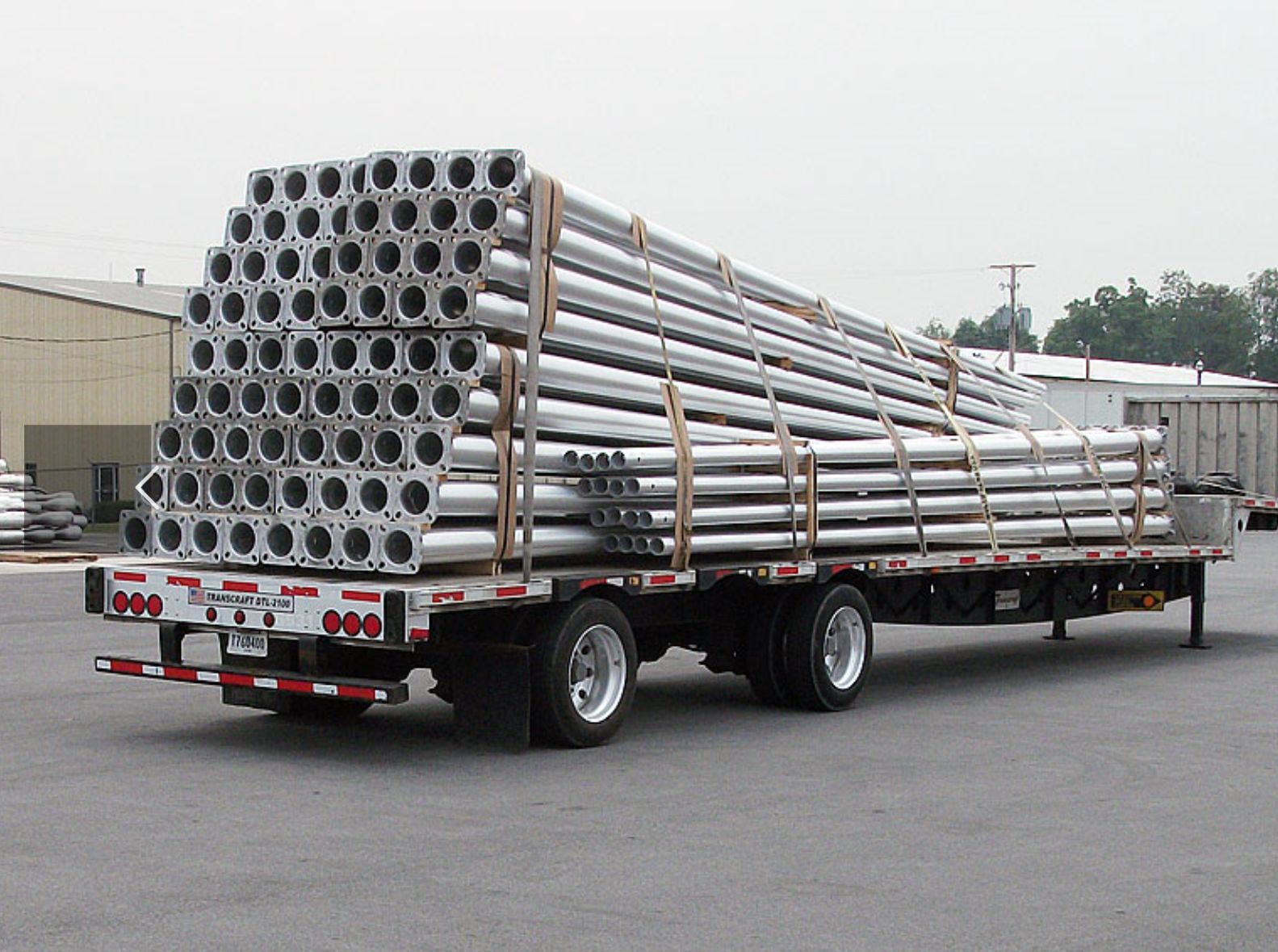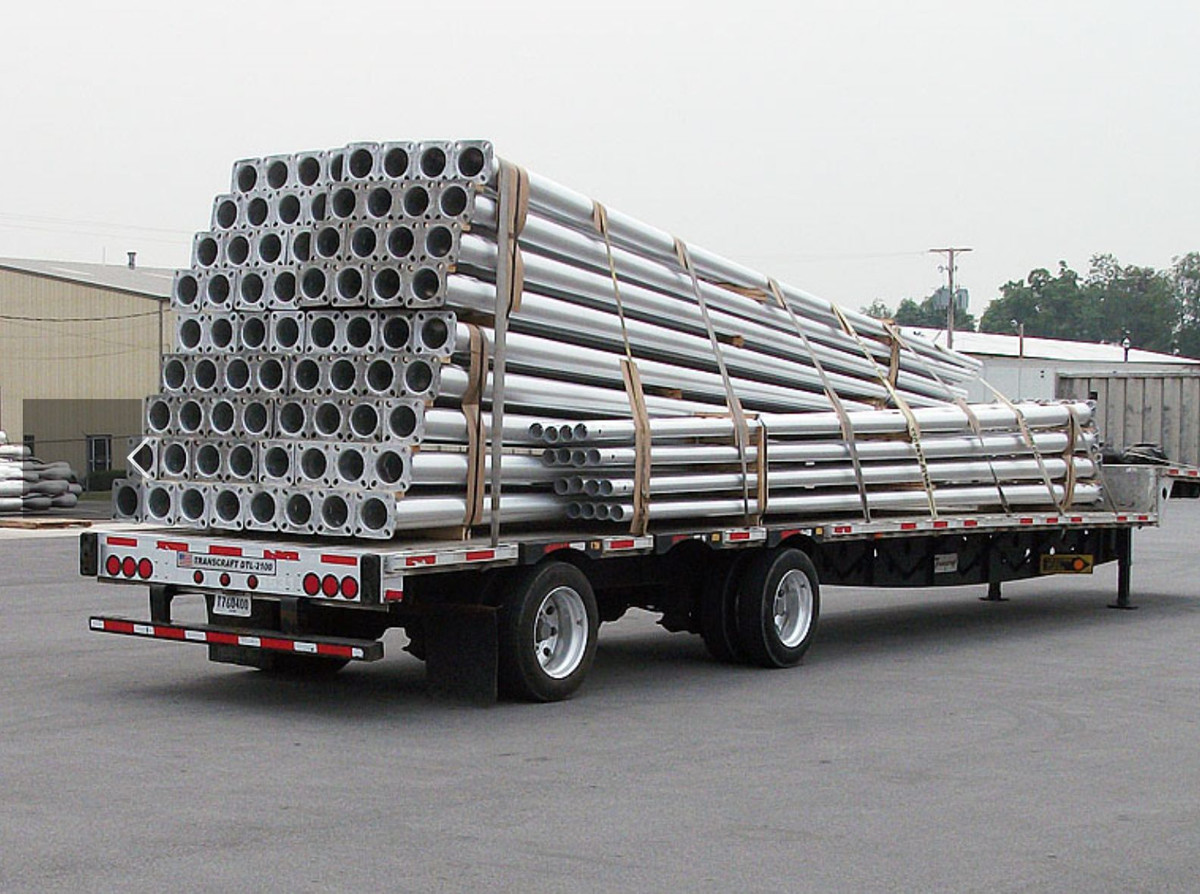It would seem obvious, but it can’t be overstated that light poles require special shipping and handling due to their awkward size. Even the shortest ones, at 8 feet, provide a challenge. Light poles can’t be shipped using standard carriers such as UPS and FedEx. Because of this, brokered independent carriers are used that can capably deliver them without damage.
Additionally, most manufacturers do not keep light poles in stock. Because of this, they are usually made to order, which means 4-6 weeks (or more) lead times. These long lead times require extra planning when it comes to outdoor lighting projects.
This article will help guide you through the entire process so that you can be better prepared to receive, inspect, and store your light poles.
Light Pole Shipping

The delivery process for light poles requires experienced carriers who can safely handle the load. In most cases, flatbed trucks are used for transport because the poles can be laid on their sides and strapped down. The other benefit of transporting poles on flatbed trucks is that it is easier to load and unload them from multiple angles.
Delivering light poles isn’t the only consideration. Customers or contractors have certain responsibilities when offloading the poles at a job site. They’ll need proper equipment such as cranes or forklifts to ensure that the poles are not damaged.
Unlike other types of deliveries that are made at a broad range of times and/or dates, it’s important to note that you’ll need to make an appointment with the carrier for your pole delivery at a specific time. This is due to the more complex nature of the delivery/unloading/ inspection process. This must be planned in advance because the receiver can incur potential additional charges related to re-consignment or unloading delays.
Additional considerations must be made for residential deliveries. You’ll need to ensure that the carrier can easily enter and leave the area. Their trucks are large, and they need to have the ability to safely maneuver in and out. For example, if a delivery is being made to a townhouse complex, the driver may refuse to enter if it’s determined that there are safety or logistical concerns.
Light Pole Inspection
It is imperative that the poles and their associated hardware are inspected upon delivery. In some cases, they are routed through various hubs along the way to their destination which means that they will be loaded and unloaded more than once. This increases the chance of damage or missing items. You won’t be able to complete your installation if there are any delivery issues.
It’s also important to know that once a bill of lading has been signed by the receiver after delivery, it is essentially a legal contract that states that all items were delivered and in satisfactory condition. Discovering issues after the fact could lead to delays and additional costs.
Guide to pole inspection
- Remove the wrapping.
- Check for any damage that might have occurred from transport. This includes scratches on the pole. Be sure to check for concealed damage underneath the poles which might not be seen at first glance.
- Inspect and count all related hardware such as anchor bolts, hand hole covers, pole top caps, mounting brackets, etc.
- Ensure that the pole color matches the order.
- If the associated light fixtures and/or mounting brackets were purchased separately from the poles, make sure to check that the poles’ bolt patterns match up so that there is no issue with mounting them. Do this while the carrier is still there so that if there is an issue, the poles can be more easily returned.
- Make a note of any issues with the delivery receipt and contact the manufacturer immediately if there are problems.
Light Pole Storage
Even though light poles are designed to withstand harsh outdoor weather conditions, it’s important to understand that this only applies when they have been installed and are standing up. When they are being stored before installation, they are vulnerable to damage because they are usually lying on top of each other.
Light Pole Storage Tips
- Remove all wrapping before storing the poles.
- Store the poles indoors where possible.
- Store the poles off the ground so that they don’t come in contact with water or snow.
- Be sure to alternate poles top to bottom and bottom to top when stacking them.
- Use padded dunnage to separate the poles from each other. Ensure that the dunnage is directly in line with one another to apply equal pressure on the poles. This will prevent the poles from being damaged during storage.
- Use loose untreated wood to help absorb moisture as needed.
Do NOT do the following:
- Leave wrapping on the pole as it can cause damage to the finish.
- Use cardboard. This can trap water and allow condensation to build. This causes staining.
- Use wet dunnage or dunnage with a chemical makeup as it can damage the finish.
LightMart Quick Ship Light Poles
LightMart carries some common types of high quality light poles in stock that can be shipped immediately. This helps to avoid long lead times.
Pole types include:
- Direct burial round tapered fiberglass, 6- to 10-inch diameter
- Anchor-based square steel, 7- or 11-gauge, 3- to 4-inch width
- Direct burial and anchor-based round aluminum, 3- to 4-inch diameter
- Pole heights range from 8 to 30 feet.
We can also pre-ship anchor bolts (if applicable) that will arrive before the poles do.
LightMart’s quick ship light poles allow you to complete your lighting project quickly and efficiently while using high quality products without having to spend a lot of time waiting for your materials to arrive. We pride ourselves on providing superior customer service and support. Get started by contacting us today!
David DeWald is the E-Commerce Marketing Specialist at LightMart. He has been working in the industrial and commercial lighting industry since 2013 and is based in the greater Chicago area. David specializes in digital product management, web content writing, and product marketing. He regularly publishes lighting industry-related articles on the LightMart blog. You can visit his LinkedIn profile here.
